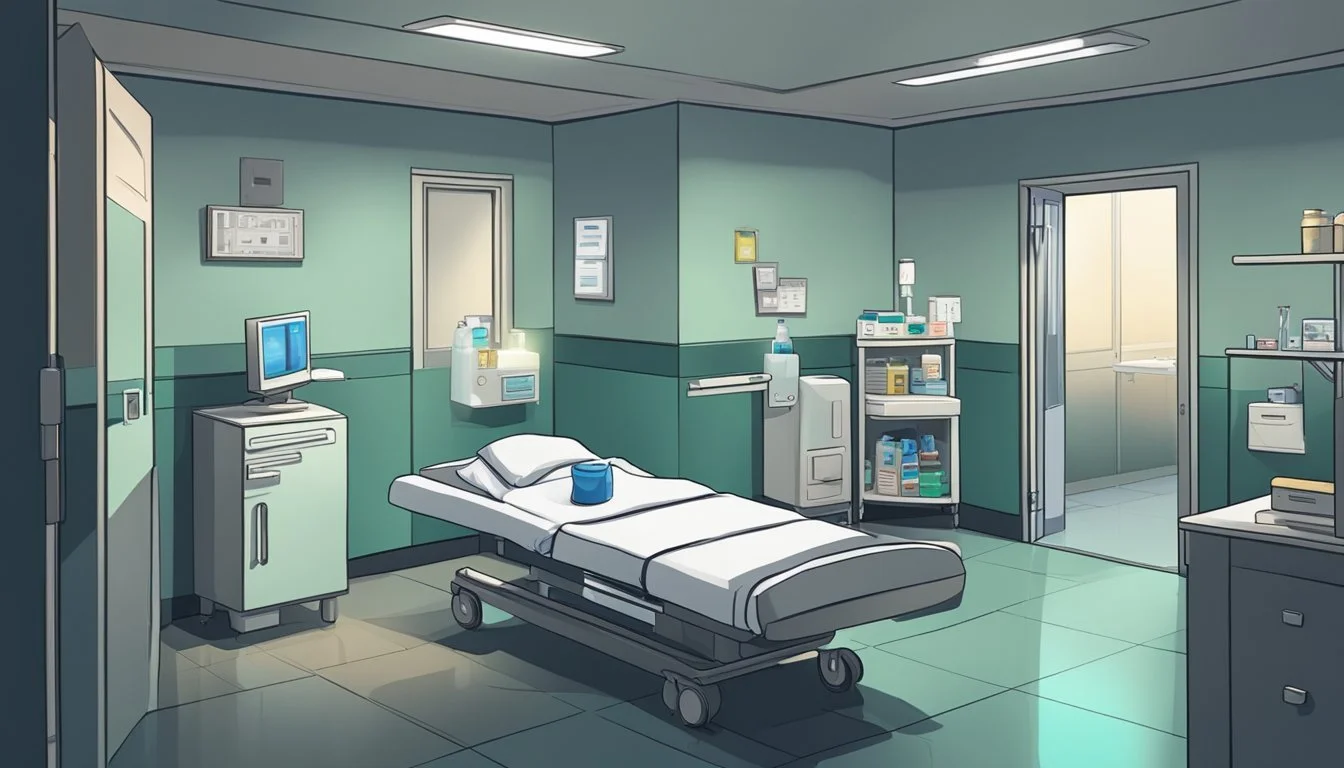Donald Harvey's Final Injection: Angel of Death Meets Fate Behind Bars
Donald Harvey, notorious as the "Angel of Death," met an ironic end on March 30, 2017, when he was fatally attacked in his prison cell. The former hospital orderly had confessed to killing 37 patients during his tenure in healthcare facilities across Ohio and Kentucky from 1970 to 1987.
Harvey's reign of terror came to light in 1987 when he pleaded guilty to the murders. He carried out his crimes through various methods, primarily poisoning, while working as a nurse's aide in hospitals in Cincinnati, Ohio, and London, Kentucky. His victims were mostly patients under his care, whom he claimed to have killed out of mercy.
The attack on Harvey occurred at the Toledo Correctional Institution in Ohio, where he was serving multiple life sentences. His death at age 64 marked the end of a dark chapter in American healthcare history, leaving many to ponder the vulnerabilities within the medical system that allowed his crimes to go undetected for so long.
Prologue to a Killer's End
Donald Harvey, infamously known as the "Angel of Death," spent decades working in healthcare facilities across Ohio and Kentucky. His seemingly benign role as a hospital orderly masked a sinister truth.
Harvey's killing spree began in the 1970s and continued into the 1980s. He targeted vulnerable patients, using various methods to end their lives prematurely.
Estimates of Harvey's victims range from 36 to 57 people. His preferred method was poisoning, though he employed other means as well.
In 1987, Harvey's reign of terror came to an end. He was arrested and subsequently confessed to his crimes. The justice system responded swiftly, sentencing him to multiple life terms.
For nearly three decades, Harvey resided behind bars at the Toledo Correctional Institution in Ohio. His notoriety as the "Angel of Death" followed him, a constant reminder of his dark past.
On March 28, 2017, fate took an unexpected turn. Harvey was found severely beaten in his prison cell. The attack left him with massive head trauma and multiple skull fractures.
Two days later, on March 30, 2017, Donald Harvey succumbed to his injuries. The man who had taken so many lives met his own end in a violent manner, bringing a final chapter to his infamous story.
The Dark Persona Unveiled
Donald Harvey's transformation into the "Angel of Death" reveals a disturbing journey from ordinary hospital worker to prolific serial killer. His actions exposed deep flaws in healthcare security and shed light on the complex psychology behind medical murder.
The Making of an Angel of Death
Donald Harvey's path to becoming a killer began in his youth. Born in 1952 in Hamilton, Ohio, Harvey had a troubled childhood marked by alleged sexual abuse. He dropped out of high school and began working in healthcare facilities in his late teens.
Harvey's first known murder occurred in 1970 at Marymount Hospital in London, Kentucky. He smothered a stroke patient with a pillow, later claiming it was an act of mercy. This event sparked a 17-year killing spree across multiple hospitals.
Harvey exploited his positions as an orderly and nurse's aide to gain unsupervised access to vulnerable patients. He used his medical knowledge to commit murders that often appeared natural, evading suspicion for years.
A Trail of Terror and Deceit
Harvey's victims numbered at least 37, though he claimed to have killed up to 87 people. His methods varied but often involved poisoning. He used cyanide, arsenic, and insulin among other substances to induce fatal medical events.
The killer targeted patients of all ages and genders. Some were terminally ill, while others were on the path to recovery. Harvey occasionally murdered colleagues and acquaintances outside the hospital setting.
His crimes went undetected for nearly two decades. Harvey's seemingly caring demeanor and the trust placed in medical staff allowed him to operate without raising alarms. It wasn't until 1987 that an autopsy revealed traces of cyanide in a patient, leading to Harvey's arrest.
The Mind of a Serial Killer
Psychological assessments of Harvey revealed a complex and disturbed individual. He displayed traits of antisocial personality disorder and narcissism. Harvey often justified his actions as mercy killings or attempts to ease hospital overcrowding.
Experts noted Harvey's desire for control and power over life and death. His role in healthcare gave him a god-like sense of authority over his patients' fates. Harvey also admitted to feeling a rush of excitement from his crimes.
The killer's gender and occupation challenged stereotypes about serial murderers. As a male nurse's aide, Harvey defied expectations and exploited societal trust in healthcare workers. His case highlighted the need for stricter oversight and background checks in medical settings.
Donald Harvey's Reign of Terror
Donald Harvey's killing spree spanned over a decade, claiming dozens of lives in hospitals across Ohio and Kentucky. He used his position as a healthcare worker to prey on vulnerable patients, employing various methods to end their lives undetected.
Body Count: Victims of the Angel
Donald Harvey, known as the "Angel of Death," confessed to murdering 37 people during his time as a hospital orderly. However, some estimates suggest his victim count could be as high as 70. His targets were primarily elderly or chronically ill patients under his care.
Harvey's killing spree began in the 1970s and continued into the 1980s. He operated in multiple healthcare facilities, including Drake Memorial Hospital in Cincinnati and the Veterans Administration Medical Center in Kentucky.
The victims ranged in age from 42 to 91, with most being older adults suffering from various ailments. Harvey claimed he acted out of mercy, but his actions were ultimately driven by a disturbing desire for control over life and death.
Instruments of Death
Harvey employed a variety of methods to kill his victims, showcasing a chilling level of creativity and resourcefulness. His primary weapons of choice included:
Arsenic: Administered in lethal doses to unsuspecting patients
Chloroform: Used to suffocate victims
Cyanide: Mixed into food or drink
Insulin: Injected in excessive amounts to cause fatal hypoglycemia
He also tampered with medical equipment, disconnected oxygen supplies, and contaminated IV bags. Harvey's access to hospital supplies and knowledge of medical procedures allowed him to carry out his crimes with alarming efficiency.
Evading Detection: A Close Call
Harvey managed to evade suspicion for years due to his unassuming demeanor and the vulnerability of his victims. Many deaths were attributed to natural causes or complications from existing conditions.
In 1971, Harvey faced a close call when he was questioned about a patient's death at Marymount Hospital in London, Kentucky. He resigned shortly after but continued his killing spree elsewhere.
It wasn't until 1987 that Harvey's crimes came to light. An autopsy revealed cyanide poisoning in a patient at Drake Hospital, leading investigators to Harvey. His eventual confession shocked the medical community and exposed the devastating consequences of his long-running reign of terror.
Final Injection: The Ironic Twist
Donald Harvey's life of murder came to an unexpected end in prison. His demise held a strange parallel to the methods he used on his victims.
The Unforeseen End
On March 28, 2017, Donald Harvey was found beaten in his cell at the Toledo Correctional Institution in Ohio. He died two days later from his injuries. The attack occurred 30 years into his multiple life sentences for murdering 37 people.
Harvey's death carried a cruel irony. As a self-proclaimed "Angel of Death," he had poisoned many of his victims with substances like cyanide. Yet his own life ended violently at the hands of another inmate.
The exact motive for the attack remains unclear. Some speculated it was retaliation for Harvey's crimes, while others suggested it stemmed from a prison dispute. Regardless, the man who once wielded the power of life and death over his patients ultimately fell victim to the violence he had inflicted on others.
The Aftermath: Impact and Reflection
Donald Harvey's crimes sent shockwaves through the healthcare system and society at large. His actions exposed critical vulnerabilities in hospital security and patient safety protocols.
Criminal Justice and Institutional Failings
Harvey's guilty plea to 37 murders in 1987 highlighted severe shortcomings in hospital hiring practices and oversight. Background checks and employee monitoring systems were found to be inadequate. The case prompted nationwide reforms in healthcare facilities.
Hospitals implemented stricter screening processes for staff. They also improved medication tracking and increased supervision of patient care. Some facilities installed surveillance cameras in high-risk areas.
The legal system faced criticism for not uncovering Harvey's crimes sooner. Questions arose about the effectiveness of death investigations in hospitals. This led to changes in how suspicious deaths were reported and examined.
The Legacy of an Angel of Death
Harvey's case continues to influence medical ethics and patient advocacy. It sparked ongoing debates about end-of-life care and the vulnerability of patients in long-term facilities.
The media coverage of Harvey's crimes raised public awareness about patient rights. This led to increased scrutiny of healthcare providers and demands for transparency.
Harvey's actions also impacted medical education. Case studies based on his crimes are now used to teach ethics and patient safety to healthcare students.
The term "Angel of Death" entered popular culture, serving as a chilling reminder of the potential for abuse in caregiving roles. Harvey's legacy remains a cautionary tale in discussions of medical malpractice and serial killers.
Literary and Cultural Parallels
Donald Harvey's case echoes themes found in gothic horror and popular culture, blurring the line between fiction and reality. His actions mirror archetypes and motifs that have long captivated audiences in literature and film.
Gothic Horror and the Angel Motif
Gothic fiction often explores the duality of human nature, a concept exemplified by Donald Harvey's "Angel of Death" moniker. This juxtaposition of angelic imagery with acts of evil recalls characters like Dracula, who combines allure with menace. Harvey's role as a healthcare worker turned killer parallels Dr. Frankenstein, a healer who becomes a creator of monsters. The hospital setting of Harvey's crimes evokes the atmospheric dread found in gothic novels, where institutions meant to help become places of horror.
Monsters Among Us: From Fiction to Reality
Harvey's story reflects a recurring theme in horror: the monster hiding in plain sight. Like Norman Bates in "Psycho" or Jack Torrance in "The Shining," Harvey appeared ordinary while concealing a sinister nature. His crimes in healthcare facilities mirror the hospital horrors depicted in countless films and books. This real-life case blurs the boundary between fictional fears and actual threats, reinforcing the unsettling idea that evil can lurk in seemingly safe spaces and trusted professions.
Horror Archetypes and Donald Harvey
Harvey embodies several horror archetypes. As a serial killer, he fits the "slasher" mold popularized in 1980s cinema. His method of killing through poisoning recalls the "mad scientist" trope. The contrast between his outward appearance and inner darkness echoes the werewolf archetype. Harvey's crimes in hospitals tap into primal fears of vulnerability and betrayal in medical settings, a common horror theme. His story serves as a chilling reminder that the monsters of fiction sometimes find real-world counterparts, making his case a source of both fascination and dread.
Ethical Considerations and Societal Discourse
Donald Harvey's case raises complex ethical questions about medical care, criminal justice, and society's fascination with serial killers. It challenges our understanding of healthcare ethics and the cultural impact of notorious crimes.
Medical Ethics and the Responsibility of Care
Harvey's actions as a hospital orderly violated the fundamental principle of non-maleficence in medical ethics. His claims of "easing pain" through murder highlight the critical importance of proper end-of-life care protocols.
Healthcare institutions must implement rigorous screening and monitoring processes to prevent potential abusers from accessing vulnerable patients. This case underscores the need for clear guidelines on pain management and end-of-life decisions.
The Harvey case also sparked debates about euthanasia and assisted suicide. While these practices remain controversial, they differ significantly from Harvey's unauthorized and malicious actions.
Cultural Impact and the Morbid Fascination
Harvey's crimes captivated public attention, tapping into a cultural fascination with serial killers. True crime media often sensationalizes such cases, raising concerns about the ethical implications of this morbid interest.
The "Angel of Death" moniker given to Harvey reflects society's tendency to mythologize serial killers. This romanticization can obscure the real horror of their crimes and diminish the victims' experiences.
Harvey's case influenced visual culture, inspiring books, documentaries, and dramatizations. These portrayals walk a fine line between informing the public and potentially glorifying a murderer.
The discourse surrounding Harvey's crimes intersects with disability studies, as many of his victims were vulnerable patients. This aspect highlights societal attitudes towards illness and dependency.
Closing Remarks
Donald Harvey's death in prison marked the end of a dark chapter in medical history. His crimes as the "Angel of Death" left a lasting impact on healthcare institutions and patient safety protocols.
Harvey's case highlighted vulnerabilities in hospital systems that allowed his actions to go undetected for years. It prompted reforms in background checks, medication tracking, and mortality reviews.
The irony of Harvey's violent demise at the hands of a fellow inmate was not lost on many observers. After claiming to have ended suffering through his killings, Harvey met his own end through an act of violence.
His story serves as a stark reminder of the sacred trust placed in medical professionals. It underscores the importance of rigorous oversight and ethical standards in healthcare settings.
Ultimately, Donald Harvey's legacy is one of tragedy - for his victims, their families, and the institutions that failed to stop him. His death closed the book on his crimes, but the lessons learned continue to influence patient care and hospital security measures today.









